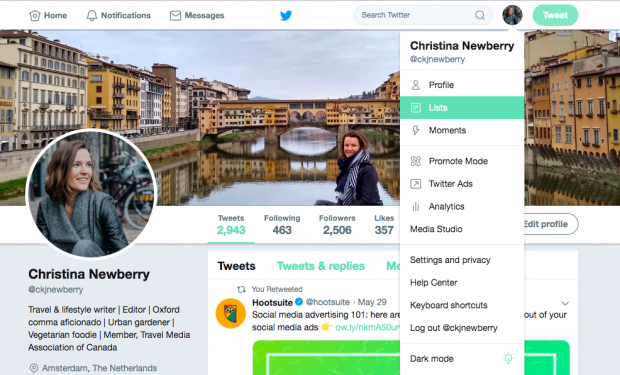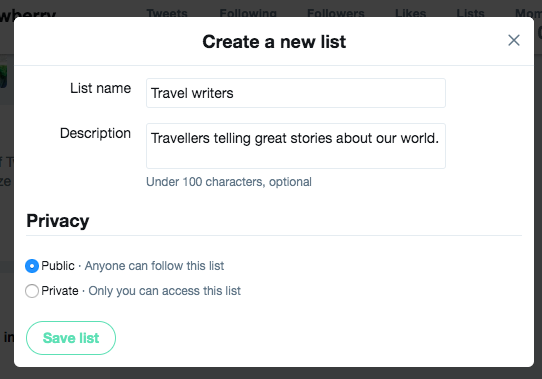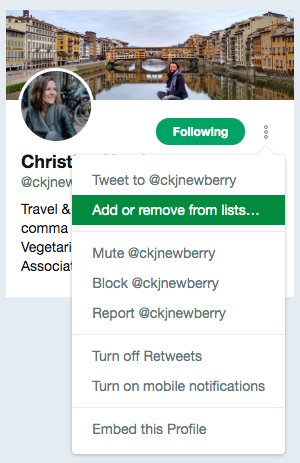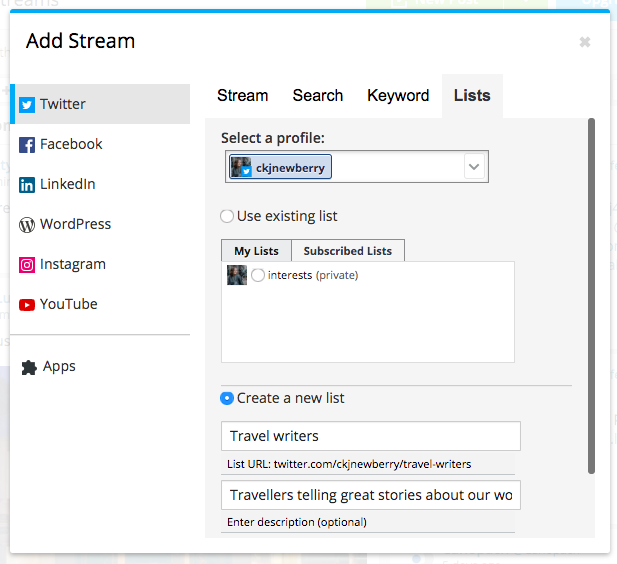How to Set Up and Use Twitter Lists: 9 Great Ideas
With 330 million monthly users, Twitter offers a vast network of potential people and brands to connect with. But with 500 million tweets sent per day, the sheer volume can make it seem impossible to keep up with your Twitter feed.
Fortunately, there’s a simple way to organize your Twitter feed into targeted topics, so you can always keep up with the most important conversations in your industry: Twitter lists.
No matter how many people you’re following on Twitter, lists offer sanity-saving organization and targeting. They also allow you to engage more effectively and keep secret tabs on the competition.
Here’s a quick primer on how to set up Twitter lists.
Bonus: Download the free strategy guide that reveals how Hootsuite grew our Twitter following to over 8 million users and learn how you can put the tactics to work for your business.
How to make a list on Twitter
On Twitter
1. Log into Twitter and click on your profile icon.
2. From the drop-down menu, choose Lists.

3. Scroll down until you see Create a list in the left sidebar. Click Create new list.
4. Enter a name and optional description for your list. Your list’s name needs to be 25 characters or less and can’t begin with a numeric character. The description can be a maximum of 100 characters.
5. Choose whether to make your list public or private. If it’s public, anyone on Twitter will be able to see and subscribe to your list. If it’s private, only you can see it.
6. Click Save list.

7. You’ll land on a page that invites you to add people to your new list. There are three ways to add people:
-
- Search for individual users by name or username
- Go to your Following page and click the three dots icon for any user, then choose Add or remove from lists
- Go to any user’s profile page, click the three dots icon, and choose Add or remove from lists

You can add or delete people from your Twitter lists at any time using the options in step seven.
To view your lists, click on your profile icon and choose Lists again. If your new list doesn’t appear right away, try refreshing the page and clearing your cache.
These screenshots show how to set up Twitter lists using a computer. The icons and labels differ a bit on mobile devices, but the process is essentially the same.
Using Hootsuite
1. Select the Streams icon from the launch menu.
2. Click the tab to which you want to add your new Twitter list. (Hint: Create a new tab called Lists to view your lists all in one place.)
3. Click Add Stream.
4. Select your Twitter profile and click the Lists tab on the right.
5. Click Create a new list.
6. Enter a name and optional description for your list. Your list’s name needs to be 25 characters or less and can’t begin with a numeric character. The description can be a maximum of 100 characters.
7. Choose whether to make your list public or private. If it’s public, anyone on Twitter will be able to see and subscribe to your list. If it’s private, only you can see it.

8. Click Add Stream.
To add people to your list, click on their username on any of your existing Twitter streams and click Add To List.
You can also add existing Twitter lists to your Hootsuite dashboard. Follow steps one through four above. Then, choose Use existing list instead of Create a new list.
Bonus: Download the free strategy guide that reveals how Hootsuite grew our Twitter following to over 8 million users and learn how you can put the tactics to work for your business.
Get the free guide right now!Just in case you get really, really into lists, here are some limits to keep in mind.
- You can create a maximum of 1,000 lists per Twitter account
- Each list can contain a maximum of 5,000 accounts
9 ways to use Twitter lists to grow your brand
1. Keep an eye on the competition
Twitter is a great tool for keeping an eye on the competition. But you don’t want to reward competitors with a follow, or let them know that you’re monitoring their tweets.
You don’t need to follow people to add them to a list. That makes private lists a great way to keep track of groups of users you don’t necessarily want to follow. Just make sure to double-check that your competitors list is set to private before you start adding accounts to the list. If it’s public, each competitor will get a notification when you add them.
In addition to monitoring tweets, lists offer another way to keep tabs on the competition.
From each competitor’s profile page, you can see what lists they’re subscribed to, and what lists they’re included on. This can give you valuable information about who your competitors are keeping an eye on and interacting with, so you can do the same.
2. Showcase employees or brand advocates
When you create a public list of employees or brand advocates, you make it easy for any Twitter user to see what your best brand cheerleaders are saying on the network. It’s also an easy way to give a little recognition to your biggest fans.
If you run a Twitter chat, you could create a list for regular participants, or for your guest co-hosts. For example, Madalyn Sklar maintains a list of guests from the #TwitterSmarter weekly chat.
A list like this can also be a great way of getting more exposure for your brand content. For example, Mashable’s list of its staff has nearly 10,000 subscribers. That’s 10,000 people seeing all the content shared by Mashable staffers, which will certainly include plenty of Mashable content.
3. Highlight your different offerings or brand accounts
Once your brand reaches a certain size, you might have a number of different Twitter accounts for different products or product lines. A Twitter list is a great way to bring all of these offerings together in one place.
For example, Netflix has a Twitter list showcasing tweets from its various show accounts and from actors in those shows. Major League Baseball has a Twitter list of all the various MLB club accounts.
You might also have different Twitter accounts for different regions. Or for different functions, like marketing versus social customer service. A list is a great way to connect and share these accounts. For example, Hootsuite has a list of official Hootsuite Twitter accounts, including regional accounts, customer service, partners, and careers.
4. Monitor relevant conversations
Since a Twitter list is essentially a curated mini-Twitter feed, creating Twitter lists based on topics relevant to your industry is a great way to make sure you’re always up-to-date on the most important conversations in your niche. Smartly crafted feeds can be a great tool for social listening.
Of course, you’re not the only one creating Twitter lists. There are likely all kinds of Twitter lists out there already that are packed full of great content relevant to your niche. Why not take advantage of the work your industry peers have done by subscribing to their lists?
To find relevant lists to subscribe to, head to the Twitter profiles of relevant people or accounts in your niche. Click on the Lists tab, and look at what lists they’ve created, subscribed to, and been added to. For example, Google Analytics maintains a list of women working in the analytics field.
When you find a list that interests you, click on the name of the list, then click Subscribe. This subscribes you to the content of the list without having to follow the lists’ members.
5. Engage influential people and accounts in your industry
Whenever you add someone new to a public list, they will get a notification letting them know you have done so. This is an easy way to get attention from accounts that may not have noticed you on Twitter yet.
But even more important, a Twitter list of influencers or other important people in your industry gives you a great collection of accounts to monitor for engagement opportunities. Open this list when you have time set aside for active Twitter participation, so you can leap in with some responses, retweets, and likes.
6. Connect before or after an event
Connecting in person at an event is great, but it can be hard to keep track of all the business cards you pick up and remember who was who.
A Twitter list can be a good way to meet some of your fellow attendees even before the event takes place, so you can prioritize who you want to meet during your limited in-person time.
After the event, a Twitter list of attendees serves as an easy way of continuing to network online.
Check the Twitter profile of the event’s host or sponsor to see if they have already created a Twitter list of attendees. It’s becoming more common, but if the event is not in the tech or social sphere, the hosts may not have thought of a Twitter list as an added benefit for attendees. You could reach out to suggest they create one.
If the hosts don’t create a Twitter list of attendees, you could create your own. It likely won’t be complete, but you could make a good start with any people you connect with directly at the event, plus the speakers list. You could also add people who tweet with the event’s hashtag.
7. Monitor which lists you appear on
You’ll get a notification every time you’re added to a public list. When someone adds you to a list, it’s a good sign that they’re interested in what you’re up to. Take a look at their profile to see if it might be appropriate to follow them or add them to one of your own lists in return.
You might also want to consider creating a private Twitter list of people who have added you to lists. Think of it as a way of collecting leads.
From time to time, it’s a good idea to check which lists you appear on and make sure there are none that cause you concern. For example, I’m currently on 93 lists, mostly relating to writing, travel, and food. (That’s great, since these are three of my favorite things.)
To find what lists you’re a member of, head to your Twitter profile and click Lists, then click Member of. Take a look just to make sure there’s nothing that causes concern, since this information is public.
The only way to remove yourself from a list is to block the list’s creator. Before taking this step, you could try contacting the list creator and asking them to remove you, but there is no other way to simply remove yourself from a list. If you wish, you can unblock the Twitter user again right away, but they will no longer be following you.
8. Share Twitter lists
Once you’ve created or discovered a great Twitter list, you might want to share it as a helpful resource. To share a Twitter list, simply navigate to the list, then copy and paste the URL. The format is always as follows:
https://twitter.com/[username]/lists/[listname]
So, for example, the URL for the list of official Hootsuite Twitter accounts is:
https://twitter.com/hootsuite/lists/hootsuite-official
9. See what you want to see, when you want to see it
The Twitter algorithm can put a confusing jumble of tweets into your Top Tweets feed. A Twitter list allows you to create your own priority collection of the accounts whose tweets you want to see first.
You can also create multiple Twitter lists to prioritize various accounts for various times. For example, during your morning commute, you might want to prioritize accounts that are likely to share breaking news. During working hours, you’ll likely want to focus on accounts relevant to your job. At lunch, you might want to focus on humor. And on your commute home, you might want to check in on what your friends and family have been up to.
You can create a separate list for each of these sets of accounts. You might want to keep your commute and humor lists private, but create a public list of the people you follow in your niche. Or, you could go fully stealth and keep your niche list private, too. Just remember that a public list is fully public, and anyone can see it and subscribe.
Use Hootsuite to manage your Twitter presence alongside all your other social media profiles. From a single dashboard you can schedule and publish posts, monitor relevant conversations, engage the audience, run ads, measure performance, and much more. Try it free today!
The post How to Set Up and Use Twitter Lists: 9 Great Ideas appeared first on Hootsuite Social Media Management.
Categories
- 60% of the time… (1)
- A/B Testing (2)
- Ad placements (3)
- adops (4)
- adops vs sales (5)
- AdParlor 101 (43)
- adx (1)
- algorithm (1)
- Analysis (9)
- Apple (1)
- Audience (1)
- Augmented Reality (1)
- authenticity (1)
- Automation (1)
- Back to School (1)
- best practices (2)
- brand voice (1)
- branding (1)
- Build a Blog Community (12)
- Case Study (3)
- celebrate women (1)
- certification (1)
- Collections (1)
- Community (1)
- Conference News (1)
- conferences (1)
- content (1)
- content curation (1)
- content marketing (1)
- contests (1)
- Conversion Lift Test (1)
- Conversion testing (1)
- cost control (2)
- Creative (6)
- crisis (1)
- Curation (1)
- Custom Audience Targeting (4)
- Digital Advertising (2)
- Digital Marketing (6)
- DPA (1)
- Dynamic Ad Creative (1)
- dynamic product ads (1)
- E-Commerce (1)
- eCommerce (2)
- Ecosystem (1)
- email marketing (3)
- employee advocacy program (1)
- employee advocates (1)
- engineers (1)
- event marketing (1)
- event marketing strategy (1)
- events (1)
- Experiments (21)
- F8 (2)
- Facebook (64)
- Facebook Ad Split Testing (1)
- facebook ads (18)
- Facebook Ads How To (1)
- Facebook Advertising (30)
- Facebook Audience Network (1)
- Facebook Creative Platform Partners (1)
- facebook marketing (1)
- Facebook Marketing Partners (2)
- Facebook Optimizations (1)
- Facebook Posts (1)
- facebook stories (1)
- Facebook Updates (2)
- Facebook Video Ads (1)
- Facebook Watch (1)
- fbf (11)
- first impression takeover (5)
- fito (5)
- Fluent (1)
- Get Started With Wix Blog (1)
- Google (9)
- Google Ad Products (5)
- Google Analytics (1)
- Guest Post (1)
- Guides (32)
- Halloween (1)
- holiday marketing (1)
- Holiday Season Advertising (7)
- Holiday Shopping Season (4)
- Holiday Video Ads (1)
- holidays (4)
- Hootsuite How-To (3)
- Hootsuite Life (1)
- how to (5)
- How to get Instagram followers (1)
- How to get more Instagram followers (1)
- i don't understand a single thing he is or has been saying (1)
- if you need any proof that we're all just making it up (2)
- Incrementality (1)
- influencer marketing (1)
- Infographic (1)
- Instagram (39)
- Instagram Ads (11)
- Instagram advertising (8)
- Instagram best practices (1)
- Instagram followers (1)
- Instagram Partner (1)
- Instagram Stories (2)
- Instagram tips (1)
- Instagram Video Ads (2)
- invite (1)
- Landing Page (1)
- link shorteners (1)
- LinkedIn (22)
- LinkedIn Ads (2)
- LinkedIn Advertising (2)
- LinkedIn Stats (1)
- LinkedIn Targeting (5)
- Linkedin Usage (1)
- List (1)
- listening (2)
- Lists (3)
- Livestreaming (1)
- look no further than the new yorker store (2)
- lunch (1)
- Mac (1)
- macOS (1)
- Marketing to Millennials (2)
- mental health (1)
- metaverse (1)
- Mobile App Marketing (3)
- Monetizing Pinterest (2)
- Monetizing Social Media (2)
- Monthly Updates (10)
- Mothers Day (1)
- movies for social media managers (1)
- new releases (11)
- News (72)
- News & Events (13)
- no one knows what they're doing (2)
- OnlineShopping (2)
- or ari paparo (1)
- owly shortener (1)
- Paid Media (2)
- People-Based Marketing (3)
- performance marketing (5)
- Pinterest (34)
- Pinterest Ads (11)
- Pinterest Advertising (8)
- Pinterest how to (1)
- Pinterest Tag helper (5)
- Pinterest Targeting (6)
- platform health (1)
- Platform Updates (8)
- Press Release (2)
- product catalog (1)
- Productivity (10)
- Programmatic (3)
- quick work (1)
- Reddit (3)
- Reporting (1)
- Resources (34)
- ROI (1)
- rules (1)
- Seamless shopping (1)
- share of voice (1)
- Shoppable ads (4)
- Skills (28)
- SMB (1)
- SnapChat (28)
- SnapChat Ads (8)
- SnapChat Advertising (5)
- Social (169)
- social ads (1)
- Social Advertising (14)
- social customer service (1)
- Social Fresh Tips (1)
- Social Media (5)
- social media automation (1)
- social media content calendar (1)
- social media for events (1)
- social media management (2)
- Social Media Marketing (49)
- social media monitoring (1)
- Social Media News (4)
- social media statistics (1)
- social media tracking in google analytics (1)
- social media tutorial (2)
- Social Toolkit Podcast (1)
- Social Video (5)
- stories (1)
- Strategy (601)
- terms (1)
- Testing (2)
- there are times ive found myself talking to ari and even though none of the words he is using are new to me (1)
- they've done studies (1)
- this is also true of anytime i have to talk to developers (1)
- tiktok (8)
- tools (1)
- Topics & Trends (3)
- Trend (12)
- Twitter (15)
- Twitter Ads (5)
- Twitter Advertising (4)
- Uncategorised (9)
- Uncategorized (13)
- url shortener (1)
- url shorteners (1)
- vendor (2)
- video (10)
- Video Ads (7)
- Video Advertising (8)
- virtual conference (1)
- we're all just throwing mountains of shit at the wall and hoping the parts that stick don't smell too bad (2)
- web3 (1)
- where you can buy a baby onesie of a dog asking god for his testicles on it (2)
- yes i understand VAST and VPAID (1)
- yes that's the extent of the things i understand (1)
- YouTube (13)
- YouTube Ads (4)
- YouTube Advertising (9)
- YouTube Video Advertising (5)
